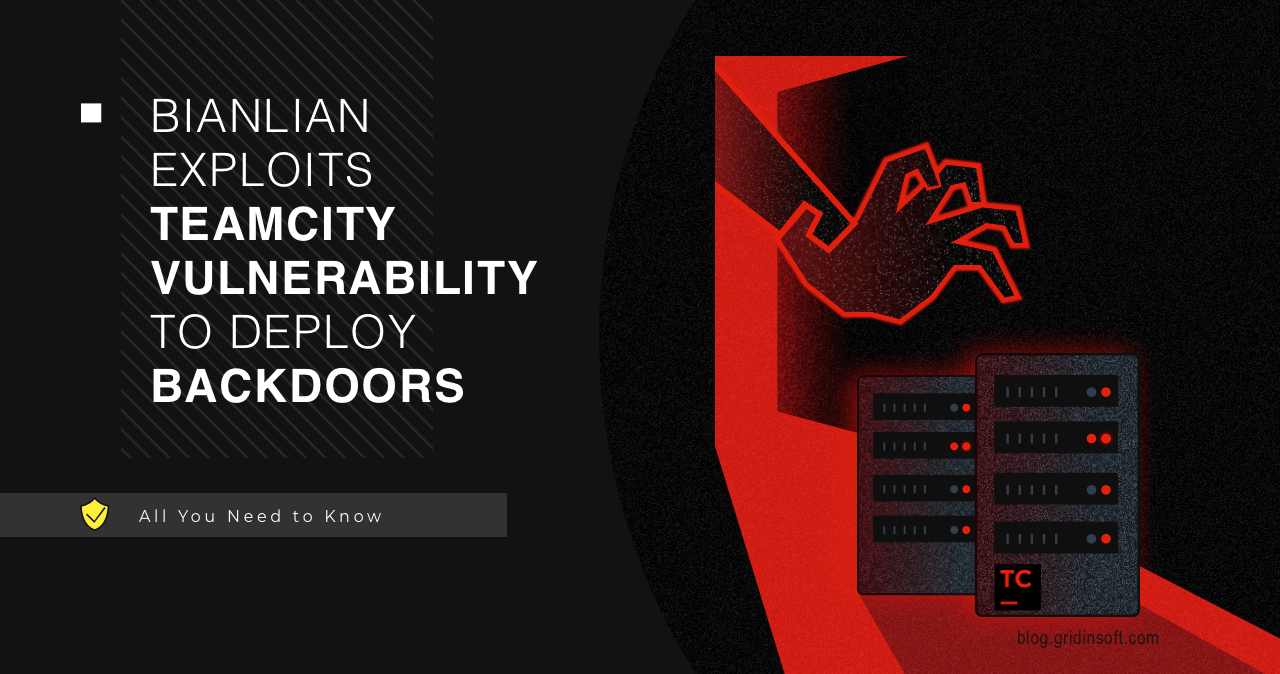BianLian, a group of cybercriminals known for their ransomware attacks, recently caught the attention of the information security community. By exploiting vulnerabilities in the JetBrains TeamCity platform, they managed to carry out multistage cyberattacks. Threat actors reportedly start their attack chain with a Golang-based backdoor, and work their way all the way to the ransomware payload.
BianLian Exploits TeamCity vulnerabilities
Recent research uncovered a new trend in BianLian’s modus operandi. They revealed that threat actors behind the ransomware have been observed exploiting security flaws in JetBrains TeamCity software to conduct their attacks. Leveraging known vulnerabilities such as CVE-2024-27198 or CVE-2023-42793, attackers gained initial access to the environment, paving the way for further infiltration. By creating new users and executing malicious commands within the TeamCity infrastructure, threat actors orchestrated post-exploitation maneuvers and lateral movement, expanding their foothold in the victim’s network.
Backdoor Deployment via PowerShell
The original report from GuidePoint Security says that despite initial success, BianLian fell back to a PowerShell version of their backdoor. This happened due to the surprising detection from Microsoft Defender. At the same time, hackers managed to deploy the network reconnaissance tools and use them before going for a PS backdoor.
The PowerShell backdoor version, obfuscated to hinder analysis, exhibited a multi-layered encryption scheme. Still, it was possible to understand what was going on and analyze the adversaries’ actions. Malware established a tunnel connection to the command server, waving ready for further actions. And while using PS in cyberattacks is not something unusual, entire backdoors based on PS, that also incorporates high levels of obfuscation, is a new tactic.
Functionality and Capabilities of Backdoor
The PowerShell backdoor described above mainly aims at facilitating covert access and control over compromised systems. Research summary reveals several features of this malware to be aware of.
The backdoor incorporates functionality to resolve IP addresses based on provided parameters, establishing TCP sockets for communication with remote command-and-control (C2) servers. Also, this enables bidirectional data exchange between the compromised system and the attacker-controlled infrastructure. Here is the code recovered by analysts:
#Function to Resolve IP address
function cakest{
param($Cakes_Param_1)
IF ($Cakes_Param_1 -as [ipaddress]){
return $Cakes_Param_1
}else{
$Cakes_Resolved_IP = [System.Net.Dns]::GetHostAddresses($Cakes_Param_1)[0].IPAddressToString;
}
return $Cakes_Resolved_ IP
}
Leveraging asynchronous execution techniques, the backdoor optimizes performance and evades detection by utilizing Runspace Pools. This allows multiple PowerShell instances to run concurrently, enhancing operational efficiency during post-exploitation activities.
Also, to ensure secure communication, the backdoor establishes SSL streams between the compromised system and C2 servers, encrypting data exchanged over the network. By employing encryption, threat actors mitigate the risk of interception and detection by network monitoring tools. Overall, the C2 communication bears on this code:
function cookies{
param (
#Default IP in parameter = 127.0.0.1
[String]$Cookies_Param1 - "0x7F000001",
[Int]$Cookies_Param2 - 1080,
[Switch]$Cookies_Param3 - $false,
[String]$Cookies_Param4 - "",
[Int]$Cookies_Params - 200,
[Int]$Cookies_Param6 - 0
)
Mimicking tactics observed in advanced malware, the backdoor validates SSL certificates presented by C2 servers, verifying the authenticity of remote endpoints. This authentication mechanism enhances the resilience of the communication channel against potential interception or infiltration attempts.
How to stay safe?
The BianLian threat group continues to evolve, and in light of their recent attacks, it is important to take appropriate security measures. Fortunately, they are more or less the same even for protecting against high-profile cybercrime groups.
- First and foremost, it is recommended to regularly update and patch externally facing applications. This helps mitigate known vulnerabilities that threat actors may exploit to infiltrate your systems.
- Ensure your team is well-versed in incident response procedures. Every member of your team should have a thorough understanding of how to respond effectively to security incidents. Regular drills should be conducted to refine response strategies and minimize the impact of potential security breaches.
- Conduct penetration tests informed by threat intelligence to proactively identify and address weaknesses in your defenses. Penetration tests involve simulated attacks on your systems to uncover vulnerabilities that could be exploited by malicious actors. By using threat intelligence to inform these tests, you can focus on the most impactful threats facing your organization.
- Additionally use advanced security solutions. EDR and XDR are a must, when we talk about corporate-grade cybersecurity. They can cover large networks of computers, orchestrating the response and detecting even sophisticated attacks like the one I’ve described above.





